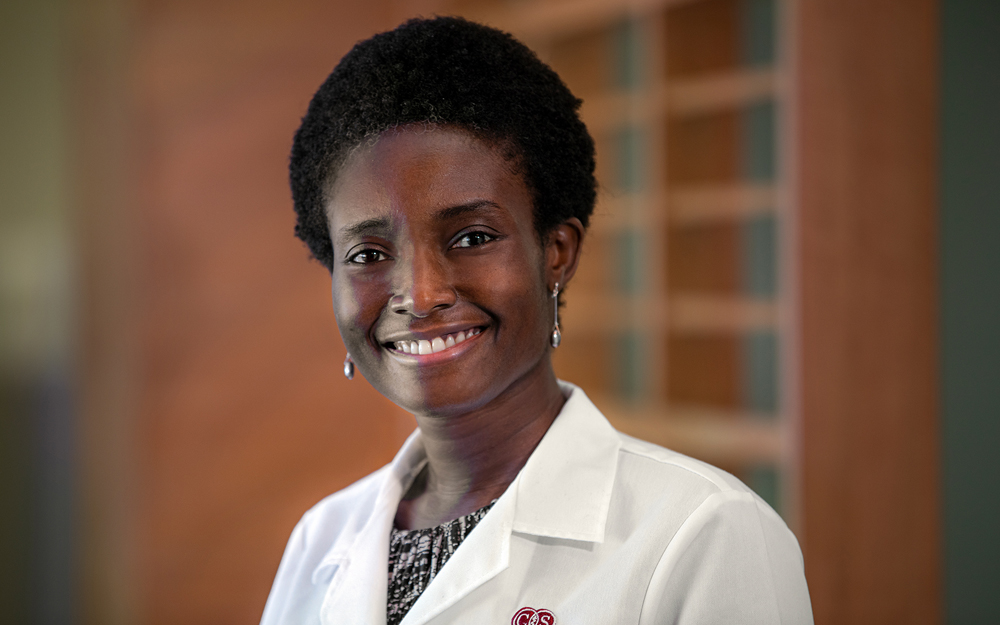Cedars-Sinai Blog
Faces of Cedars-Sinai: Neurointensivist Dr. Maranatha Ayodele
Nov 03, 2020 Victoria Pelham

How can patients best recover from a brain injury?
That's the question at the forefront of Dr. Maranatha Ayodele's work—whether it's studying new treatment options or adapting to a virus that is causing brain damage for some. As an intensive care neurologist in the Department of Neurology and Neurosurgery, she treats patients who both have brain damage and are critically ill.
"What makes it worth it is realizing that the human body has an incredible ability to heal, given time."
Because her patients are so ill, she spends much of her time focused on getting them stable and countering the systemic side effects a traumatic brain injury (TBI) has on the rest of their body. In turn, that helps their brains recover.
"The brain is one of the most crucial organs we have," she says. "It really coordinates all aspects of your life."
You're leading a clinical trial at Cedars-Sinai. What will your team research?
Dr. Maranatha Ayodele: With a TBI, the first hit is the initial physical trauma. The second hit happens after the initial trauma. The brain functions as a whole, so when one part is misbehaving, there's a chance the misbehaving part goes on to affect the rest of brain that wasn't part of the initial injury.
That's mediated by many different things—like swelling. When pressure in the brain goes up, unlike the skin, the skull doesn't have the ability to expand. So if we can treat elevated pressures in the brain, we can help people get through this critical period and prevent a secondary brain injury.
The standard of care is to treat pressure. We most often do that by monitoring intracranial pressure (ICP) with a monitor at the bedside. In the BOOST-3 study, we're looking at whether monitoring brain tissue oxygen levels in addition to monitoring pressure in the brain can improve outcomes after a TBI.
How has COVID-19 affected your job?
MA: As an intensive care unit doctor, a lot of our focus was using our resources to support my medical colleagues as best as possible, especially when they were taking on a lot of COVID-19 patients requiring multiple teams.
There were patients with encephalopathy (a term for any disease affecting brain function) and questions of seizures or stroke, so we ended up getting involved in their care to help manage neurologic side effects or severe neurologic illness associated with COVID-19. We also had some patients with severe brain injuries that had COVID-19.
Read: What Is a Seizure?
How did you choose your subspecialty in neurointensive care?
MA: I always thought neurology was incredibly fascinating—the science of it was really cool. But I was torn between that and surgery, as I also really liked working with my hands.
Neurology gives insight into why we are the way we are and how we function in a way that's a bit more abstract, while surgery gives you the same thing except it's more physical. I ended up with neurology because I decided, in terms of my whole life, it'd probably be a much better fit.
But then as I went through my neurology career, I discovered neurocritical care, which is a fairly new field. It was a no-brainer: the merging of all the aspects of the mind that I liked, of learning about the brain, with something that's very physical and very hands-on in critical care. It's a perfect blend.
You see patients during some of their hardest moments. How do you stay upbeat?
MA: It's important not to get jaded. What makes it worth it is realizing that the human body has an incredible ability to heal, given time.
I get patients to a point where they're stable enough to no longer be critical, but not necessarily functional, and then in time they have this incredible healing that happens—to the point where they come back and, sometimes, I don't recognize them.
You've lived all over the world, from Nigeria to Arizona and New York. What do you like about L.A.?
MA: I love the diversity of the city. I love that you can get any type of food you can think of just within a short drive—Ethiopian, Korean, Japanese, Indian, Italian, American fusion.
And I love how different it is as you go from one neighborhood to the other. If you like to drive, you don't have to go far to get out of the city, and if you like to be able to walk somewhere, sit outdoors and brunch, you can pretty much do that year-round.
When I lived on the East Coast, in the winters I'd be dying to get outside. Here, the outdoors is always open to you.

